Mars helicopter Ingenuity: First aircraft to fly on Red Planet
The first flight of the Mars helicopter was "a true extraterrestrial Wright Brothers moment."
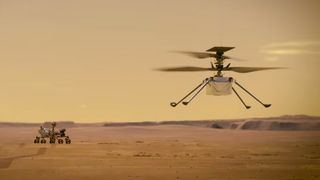
NASA's Mars helicopter Ingenuity is the first aircraft ever to fly on the Red Planet.
It launched to the red world in the summer of 2020 on NASA's Perseverance rover as part of the agency's Mars 2020 mission. They landed together on Feb. 18, 2021 in Jezero Crater — an ancient delta that scientists think could hold evidence of past life — on the surface of Mars. And, tucked into the rover's belly was the first-ever Mars helicopter, dubbed Ingenuity (a moniker given by Alabama student Vaneeza Rupani).
The "Mars helicopter has been fully tested as much as we can on Earth," MiMi Aung, the Ingenuity project manager at NASA's Jet Propulsion Laboratory (JPL) in Pasadena, California, said in a news conference ahead of the landing Feb. 16.
"To see it there, getting there finally, it's kind of surreal still," Josh Ravich, Ingenuity's mechanical engineering lead at JPL, told Space.com about the achievement.
Related: NASA powers up Ingenuity Mars helicopter in space for the 1st time
What is the Mars helicopter Ingenuity
Now, the Mars helicopter Ingenuity, or "marscopter," isn't a fully-fledged transportation device and it's vastly different from helicopters we have here on Earth. The tiny craft is "just a technology demonstration," Ravich said. "Its primary goal is just to see if we can fly on Mars — prove that the technology works."
With very little additional technology on board the actual helicopter, Ingenuity isn't designed to do science on its mission to Mars. Rather, the mission team simply wanted to prove whether or not powered flight is possible on the Red Planet, which is such a challenge because of how thin Mars' atmosphere is. (Mars has an atmospheric volume of less than 1% that of the Earth's.)
There are other challenges in flying a helicopter on Mars which include wind and dust storms and making sure the craft has enough power from its solar array.
To prepare for flight, the craft went through a number of tests, including warming up its rotor blades. At first, the helicopter "wiggled" its blades, spinning them at just 50 revolutions per minute. Then, the craft went on to spin the blades at full speed: 2,500 rpm. There was an issue with the first full-speed blade test, which pushed back the date of the first planned flight for the craft.
How big is the Mars helicopter Ingenuity
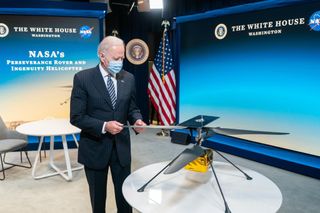
Ingenuity is a very small helicopter, weighing in at just under 4 lbs. (1.8 kilograms), though it weighs just 1.5 lbs. (0.68 kg) on Mars. The craft stands at just 19 inches (48 centimeters) tall.
Its carbon-fiber rotors, or "blades," measure just under 4 feet (1.2 meters) across. It is powered by a small solar panel mounted above its rotor blades. When it was initially deployed by the Perseverance rover, Ingenuity relied on a battery charged by the rover to stay warm through the first Martian night.
Mars Helicopter Ingenuity: How it got to Mars
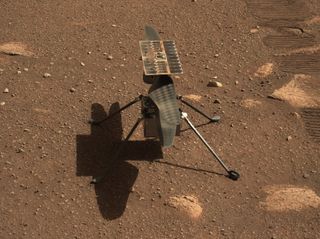
Now, while Ingenuity flew to Mars aboard Perseverance, there was a process to get the helicopter actually onto the planet's surface.
The helicopter needed to be dropped from the rover's belly where it spent its time during the interplanetary journey. To make this drop, Ingenuity had to go through what is known as the Mars helicopter delivery system. "It's a very intricate system that's going to take about 10 days to go through ... to drop Ingenuity to the surface," Aung said.
However, Aung added, "the moment that drop happens is the moment that Ingenuity has to start operating on its own in a standalone fashion."
But the tiny Martian helicopter doesn't just have the ambitious task of flying on another world, "this little four-pounder has to survive the cold frigid nights of Mars," Aung said, adding that to "keep itself warm, it has to garner energy from the sun through its solar panels to charge its battery. It has to talk to the [International] Space Station. It has to do all of that."
Thankfully, after unfurling and dropping to the planet's surface, Ingenuity's solar array was able to successfully collect solar power and keep the craft warm and "alive" through the frigid Martian nights.
The first flights of NASA's Mars helicopter Ingenuity
Despite the challenges that faced the helicopter team in trying to lift the craft off of the Martian surface, Ingenuity successfully took off for the first time on April 19. This flight saw Ingenuity lift off of the ground, hover briefly and then land back down.
The rotorcraft's first flight took it up to 10 feet (3 meters) above the Martian surface. The entire flight lasted about 40 seconds.
Ingenuity's first flight was "a true extraterrestrial Wright Brothers moment," Thomas Zurbuchen, NASA associate administrator for science at NASA Headquarters, said during the news conference Feb. 16 prior to the craft's arrival at the Red Planet.
Following this historic moment, the helicopter took off for a second time on April 22, flying higher and for a longer amount of time. The second flight lasted 52 seconds and took the craft up to 16.5 feet (5 m) above the surface, where it tilted and moved to the side before landing back down. This maneuver showcased the craft's ability to lift off and, in mid-air, turn to point its color camera in different directions.
On April 25, a third flight followed and on April 29, the helicopter attempted its fourth flight.
Unfortunately, things did not go as planned and the fourth flight did not take place this day as the helicopter failed to shift into "flight mode." However, while the mission team switched up the command sequence sent from Earth, a fix that worked to get the craft to fly for the first time, it didn't work that time. However, the craft went on to successfully complete its fourth flight on April 30.
It reached new records with this flight, hitting a top speed of 8 mph (13 kph), covering 872 feet (266 m) of ground and flying for a total of 117 seconds. The craft didn't breach the previous altitude record of 16.5 feet (5 m).
On its fifth flight May 7, the craft climbed again to 16.5 feet (5 m), flew south for 423 feet (129 m) then climbed even higher to a new record of 33 feet (10 m) and took some photos before landing after a flight totaling 108 seconds. The one-way flight took the craft to a new airfield.
Mars Helicopter Ingenuity: A new phase
As the helicopter was preparing for its fourth flight, NASA made a surprising announcement. The helicopter was originally set to be just a technology demonstration and complete up to 5 flights within 30 days of beginning its operations on the Red Planet. But, with the flights going better than planned, NASA announced that the helicopter's mission would be extended to include an "operations demonstration phase."
In this new phase, which would add at least 30 days to the previously only 30-day mission, the helicopter was tasked with scouting out a new location to fly, flying to that airfield on its fifth flight and taking pictures using the on board camera technology.
For this new leg of the mission, the helicopter also had the added challenge of doing this without Perseverance watching from close by, as the rover mission team had to begin their science mission objectives.
Related: How to watch NASA's Perseverance rover land on Mars
Mars helicopter Ingenuity: Technology and features
Ingenuity was designed as a technology demonstration and, while the craft does not carry any scientific equipment on board it still has a few key pieces of tech and a few notable capabilities that allow it to do its job on Mars.
The helicopter has a solar panel that charges Lithium-ion batteries and can provide enough energy for one 90-second flight per Martian day, or an average of 350 Watts of average power during each flight, according to NASA. Despite this limitation, the craft has flown up to 117 seconds during a flight, which it managed to accomplish on its fourth flight.
The craft also has a listed flight altitude of 15 feet (5 m), according to that same NASA document, but has flown not just to 16.5 feet (a little over 5 m) but to a whopping 33 feet (over 10 m) on its fifth flight.
Ingenuity has two blades that spin in opposite directions at about 2,400 rpm.
The only instruments on board the helicopter that does not directly allow it to fly are its two cameras. It has a wide-angle. 0.3-megapixel navigation camera and, additionally, a 12-megapixel color camera.
While the craft had some added photo help from Perseverance during its first few flights, after its fifth flight took it to a new airfield and it began a new phase in its mission, the helicopter was on its own to take images.
Mars helicopter Ingenuity: Flying on Mars
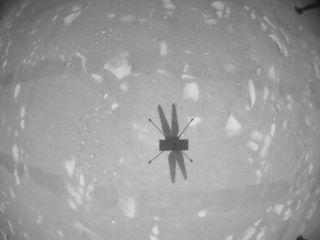
It might seem simple to get a small craft that looks like a common Earth drone to fly. However, flying on Mars was no easy feat.
As previously mentioned, Mars has an extremely thin atmosphere. Rotorcraft, or helicopters, typically lift off by pushing on air but, Aung said in an April 9 news conference, on Mars, "there are less molecules, basically, to push."
So, even though it might seem like it could even be easier to get into the air as Mars has a weaker gravitational pull (it's about 38% as strong as Earth's), the lack of atmosphere makes things very challenging.
Because the lack of atmosphere outweighs any advantage that the weaker gravitational pull might have, Ingenuity has to do things a bit differently from an Earthly helicopter.
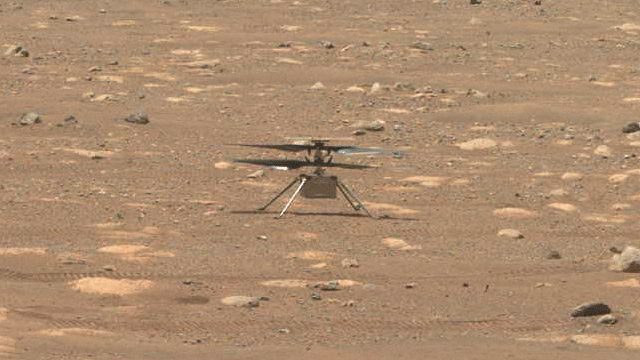
For one, the craft's blades are very large compared to its tiny body. The blades stretch about 4 feet (1.2 m) across while the entire helicopter stands just 19 in. (48 cm) tall. Its blades also spin very fast at about 2,500 RPM, much faster than would be necessary for a craft this tiny on planet Earth.
In fact, on Earth, lightweight helicopters that can carry human passengers have blades that spin at just 450 RPM on average during flight.
Ingenuity also keeps itself warm using its solar power, fending off the extreme cold temperatures on Mars. In Jezero crater where the rover landed, temperatures can drop as low as minus 117.4 degrees Fahrenheit (minus 83 degrees Celsius).
Another major challenge that mission team members had to consider in getting the craft to fly is how to actually control its flights and movements. Given the considerable distance between our two planets, the helicopter can't be controlled in real-time. Instead, they had to design it to function autonomously with directions beamed out to Mars in advance of flights and movements.
Related: How to watch the Mars helicopter Ingenuity's first flight online
Wright Brothers history on Mars helicopter Ingenuity
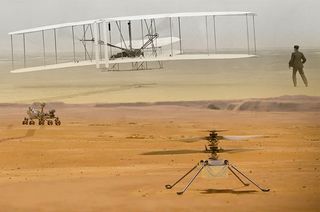
The Mars helicopter Ingenuity carried a special tribute to the history of flight when it took to the skies of the Red Planet.
The small chopper is carrying a piece of fabric from the Wright brothers' 1903 Wright Flyer 1, which became the first successful heavier-than-air powered aircraft when it first took off from Kitty Hawk, North Carolina. The fabric swatch is a tiny piece of "Pride of the West" muslin used on the Flyer's covered wings and body.
NASA also named Ingenuity's first airfield on Mars Wright Field in honor of the Wilbur and Orville Wright's pioneering work in aviation. The helicopter has since flown to a second airfield.
Mars Helicopter Ingenuity: Future applications
Now, even with the mission extension, Ingenuity's tasks on the Red Planet remain fairly simple: fly, snap photos, land, survive.
However, "there's a lot of future applications" for the craft, Ravich said.
For instance, with a vehicle like Ingenuity, "you can fly pretty far ahead pretty quickly, you can go to places you can't go otherwise: up mountains, down ravines — places that humans and rovers wouldn't really be able to access," he said. He added that such a capability could assist future robotic missions with scouting and imaging challenging terrain, and it could even one day be of assistance to crewed missions.
A helicopter compared with, for example, rovers or future human explorers, could have "access to places you can't go otherwise," Ravich added, specifying that Martian lava tubes could potentially be more easily explored by a helicopter than other vehicles, and it could do that exploration fairly quickly, or at least quicker than robotic surface vehicles like rovers.
Future crewed missions could also possibly be supported by vehicles like Ingenuity, he added. For example, "I'm out doing Mars operations as an astronaut, I forgot my wrench back home at the base. Maybe I can send a helicopter back to pick it up for me," he added.
As we continue to watch Ingenuity push its boundaries and explore its extended mission phase, we will start to see more and more of its capabilities be revealed.
Email Chelsea Gohd at cgohd@space.com or follow her on Twitter @chelsea_gohd. Follow us on Twitter @Spacedotcom and on Facebook.
Join our Space Forums to keep talking space on the latest missions, night sky and more! And if you have a news tip, correction or comment, let us know at: community@space.com.
Get the Space.com Newsletter
Breaking space news, the latest updates on rocket launches, skywatching events and more!

Chelsea “Foxanne” Gohd joined Space.com in 2018 and is now a Senior Writer, writing about everything from climate change to planetary science and human spaceflight in both articles and on-camera in videos. With a degree in Public Health and biological sciences, Chelsea has written and worked for institutions including the American Museum of Natural History, Scientific American, Discover Magazine Blog, Astronomy Magazine and Live Science. When not writing, editing or filming something space-y, Chelsea "Foxanne" Gohd is writing music and performing as Foxanne, even launching a song to space in 2021 with Inspiration4. You can follow her on Twitter @chelsea_gohd and @foxannemusic.